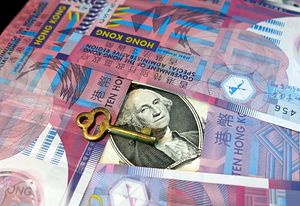Persistent uncertainty regarding China’s economic growth trajectory, coupled with volatile global markets, have brought an old target back into focus: Hong Kong’s dollar peg. Indeed, as the People’s Bank of China (PBOC) battled to keep the spread between onshore and offshore RMB in an acceptable range in January, Hong Kong’s government stepped in numerous times to defend the Hong Kong dollar-U.S. dollar peg, something it has done increasingly over the past few years. Even with greater intervention over time supporting the peg, however, traders betting on a re-pegging, or even the demise of the peg, will almost certainly be disappointed over the short term.
Hong Kong maintained a floating currency regime from 1974 to 1983, with highly undesirable results. Indeed, the floating regime essentially ended with “Black Saturday” on September 24, 1983 when high levels of exchange volatility led to an existential crisis of confidence in the Hong Kong dollar. The government’s decision to formally adopt the US dollar peg in 1984 emerged to promote stability: The territory needed to provide a stable monetary environment as a global financial and trading hub. Although the peg survived the tumultuous Asian Financial Crisis in 1997, it has come under increased fire as a result of amplified global liquidity and Hong Kong’s status as a regional financial center, as well as its status as a proxy for China’s economic health.
The most recent round of intervention largely owes to concern over China’s economy. The poorly communicated one-off revaluation by the PBOC in August 2015 put many investors on edge regarding its motives. Indeed, even if the revaluation was, as the PBOC explained, part of a larger effort to encourage market determination of the RMB’s value, it fed into investors’ existing skepticism of government statistics and the government’s ability to deal responsibly with an economic downturn after considerable financial volatility. At the same time, capital outflows, which were constant throughout 2015, accelerated after the devaluation putting greater pressure on the government to defend the currency through using foreign currency reserves.
As latent concerns remained in the new year, further global stock market volatility reignited these fears. Due to the inability to “short” the RMB in China, many investors bet on a further RMB devaluation via offshore RMB, which are essentially option contracts for the currency that are traded outside of China. As bets mounted for a further devaluation, the spread between offshore and offshore RMB, which should be close to parity, widened noticeably.
This sign of potential further depreciation, along with similar pessimism regarding Hong Kong’s economy and government resolve led some traders to turn their fire against the HKD. Indeed, the Hong Kong economy itself is clearly slowing: forecast growth is forecast at marginally below 2 percent in 2016, down from 2015 levels, with many estimates lower due to a decrease in mainland tourists and a contraction in the domestic real estate market. The US dollar peg is exacerbating this cyclical downturn as the peg “imports” tighter monetary policy from the United States when the territory should arguably adopt expansionary monetary policy.
Overall, traders’ bet against the HKD is not completely without merit, although it will not likely be realizable over the short-term. Interest in the trade is a factor of two reasons: 1) the substantial profits over a short time frame associated with previous currency trades; 2) judgment that the PBOC and by extension the Hong Kong Monetary Authority might not be able to maintain the current currency regimes.
Indeed, some traders who bet against currency pegs are still swayed by the mythic “breaking” of the Bank of England by George Soros betting on the U.K. pound leaving the European Exchange Rate Mechanism in 1992, which earned him more than a billion in profits in a short period of time. Of course, there may be differences between the artificial rate at which the Exchange Rate Mechanism was set and the HKD; however, the common thread of overvaluation may ultimately be valid.
This motivation leads to the second point: if the RMB and HKD are truly overvalued, there may be limited firepower to ultimately defend them. However, both the PBOC and HKMA have shown resolve to maintain the current exchange levels, with the PBOC not only using state-owned banks to buy options to raise the value of offshore RMB, but also raising the guidance for the currency to its lowest level (highest value) in over 10 years the day after the Chinese new year vacation. The HKMA has also successfully defended the peg within its mandated range.
While the peg is likely safe over the short-term, it will likely evolve over the longer term – five or ten years, particularly as Hong Kong’s economy becomes more integrated with that of China. At that time, a peg to the RMB, or even the circulation of RMB in Hong Kong, may not be a trader’s pipe dream.
Erik Tollefson is an Asia-based economist and analyst.

































